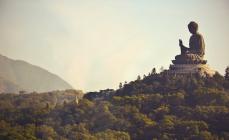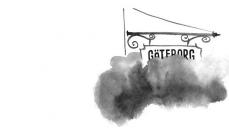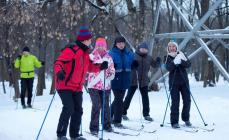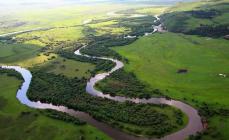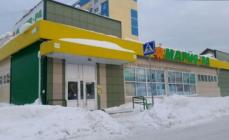Black Sea resort, unique traditions, hospitality, historical places, mild subtropical climate, bright sun and warm sea, all this is a characteristic of the resort town of Kobuleti located 25 kilometers north.
History of the city and region
Kobuleti is a relatively young city; it received this status in 1944. The main street of the city is considered the longest in Georgia, now the street bears the name of the Georgian king David the Builder, an educator who united Western and Eastern Georgia (he was the great-grandfather of the famous Queen Tamara). It is the second largest city in .
The whole life of Kobuleti is closely connected with this street, which is also part of the central Tbilisi-Batumi highway. In summer, the street is particularly crowded.
Despite the fact that the city is young, Kobuleti has been inhabited for more than one millennium. Historical monuments of the stone, antique and feudal periods were found in the vicinity. Previously, Kobuleti was part of the ancient Kolkhetian kingdom.
Historical monuments of the Stone Age were discovered during excavations in the village of Kobuleti and Khutsubani. According to archaeologists, these artifacts are at least 9,000 years old. In addition, there are many materials made in the Bronze Age.
Archaeologists have also discovered amphorae and other clay artifacts from the 5th century BC. At that time, Colchis had close ties with Ancient Greece, later, Byzantium and the Pontic kingdom.
All discovered historical values can be seen in historical museum city, opened in 2013. Despite the fact that the museum is young, it houses about 4,000 exhibits. The ethnographic department of the museum will present the life and life of the peasants of this region.
Models showing the life of the inhabitants of Kobuleti in the era of feudalism attract children and adults who are interested in the life of different peoples.
One of the unique exhibits of the museum is handwritten prayer books of the 17th-19th centuries. They are of both historical and ecclesiastical value.
In the museum you can also see the exposition of modern cultural figures of this region, learn about the outstanding residents who glorified their native land.

IN new history The Kobuleti region was a leader in the production of tea and citrus fruits. Now most of the tea plantations have been eliminated, and citrus plantations have also been greatly reduced.
In the region there was the only tung factory in the Union, where they dried and then squeezed tung oil - unique in its characteristics and valuable. Paints and varnishes for processing wood and metal were made from it.
For local population the production of honey and the cultivation of hazelnuts has become more profitable, since there are buyers for these products.
Modern city
Kobuleti is resort town: the whole life of the inhabitants, their whole life is closely connected with the sea. Urban buildings and houses start 5-10 meters from sea beach. Local boys spend their entire childhood in the water. They say that they grew up in the sea. In summer, the city is flooded with tourists who like to spend their holidays basking in the southern sun. To say that the city beach is huge is to say nothing, its length is more than 10 km, and its width ranges from five to 15 meters.

Kobuleti is administrative center district of the same name, there are many hotels in the city, a modern clinic equipped with the latest equipment, many parks, entertainment and cultural centers greet guests of the city.
Residents of Kobuleti, whose main income is associated with 2-3 months of the holiday season, are preparing their guesthouses, cafes, bars, etc. for the summer. From the end of June, the city is completely ready to receive tourists.
Since the main economic direction of the city is tourism, the service personnel for work in this area is prepared by the city itself. There is a multidisciplinary vocational school in Kobuleti, where hotel workers, guides, cooks, cooks, bartenders, electricians, welders, etc. are trained at a high level. Teachers from Europe were invited to study, and students regularly take part in international professional training competitions. Students take practical classes at tourist sites.
 Vacationers always leave Kobuleti happy and rested, unless some force majeure happens. Pleasant pastime is facilitated by warm, clear water, mild, subtropical climate and the opportunity to get acquainted with unfamiliar people and unusual reserves of the region.
Vacationers always leave Kobuleti happy and rested, unless some force majeure happens. Pleasant pastime is facilitated by warm, clear water, mild, subtropical climate and the opportunity to get acquainted with unfamiliar people and unusual reserves of the region.
All-round panorama (move the picture to look in different directions) of the beach in Kobuleti:
There are three large unique reserves and many historical monuments in the Kobuleti municipality.
Sights of Kobuleti municipality.
Fortress of Petra.
The ruins of the amazingly beautiful and unique Byzantine fortress of Petra are located on one of the hills in the village of Tsikhisdziri. Tsikhisdziri - translates as "under the fortress." Tourists see the ruins of the fortress when they travel from Kobuleti to Batumi.
Petra was considered an impregnable fortress-city in the Egris kingdom. The place where the fortress was built was of great strategic, military and commercial importance. Therefore, the Byzantine emperor Justinian decided to build it in 535.

Near the fortress there was a narrow trade route that connected Georgia with Armenia and Byzantium. There were also fierce battles against the Turkish invaders.
Now the fortress is the ruins of an archaeological complex, which includes the citadel, the outer city and residential buildings.
From the ruins, you can identify the vault that served as a refrigerator. The fortress had a well and a cistern where water was stored.
Once upon a time there was a cross at the entrance to the fortress, which later the Turkish conquerors threw down and smashed. The foundation and the ruins of a three-aisled basilica, which were probably destroyed by the Turks, have been preserved in the fortress.
You can also identify chapels of the X-XIV centuries, the ruins of a bathhouse, a wine storage.
Archaeological excavations have been carried out in the fortress since 1987, before that there was a lemonarium in the fortress, a garden in which lemons grew. Now the fortress of Petra is considered a museum-reserve.
360 degree panorama of Petra Fortress:
Unique swamps of Spain
In a 15-minute walk from the Pichvnar beach, tourists can see a completely unique and different natural area, namely the Spanish marshes. The swamps are divided into two zones: Spain-1 and Spain-2
This is an ecological reserve, as the swamps are the only untouched natural peatlands in the world covered with live sphagnum (white moss) of four types. This moss is a plant that has survived to this day from prehistoric times. The presence of sphagnum indicates the ecological cleanliness of the territory, the slightest presence of foreign substances in the air, soil or water destroys it.
In the swamp, water is filled only by rain, and is lost only through evaporation. The swamp area is 770 hectares, of which 331 hectares are protected areas, and the rest is a reserve territory.
Many tourists think that these are ordinary swamps, but in reality everything is not so. Spanish swamps are like a lake with clean drinking water, but the lake is not easy. The surface of the swamps is covered with a 25 cm layer of white moss, which never goes under water.
In these swamps to miraculous natural wealth the hands of a practical person did not have time to reach, so a unique ecosystem was preserved. Environmentalists are trying to prevent drainage work, as happened almost throughout the Colchis lowland.
During migration, 122 species of migratory birds land on these swamps, but hunting for them in the reserve is strictly prohibited. Therefore, the birds in these swamps really rest, without fear during long flights.
In addition to hunting in the swamps, it is also forbidden to collect herbariums, tourists need to know this, otherwise they may face a significant fine. The order in the swamps is monitored by groups of huntsmen (rangers), who also help tourists to get through the swamps without even harming the moss under their feet.
In the swamps, there are also plants that are not typical for the subtropical zone, which also makes this reserve unique. Oddly enough, but it is these swamps that help in the fight against mosquitoes that spread malaria and other dangerous diseases, as a predatory plant grows here - duckweed, which feeds on mosquitoes, flies and other insects.
Since 1996, Georgia has joined the Ramsar Convention and the Spani-2 reserve has received the status of wetlands of international importance.
Kintrishsky reserve
The Kintrishi reserve is located some two dozen kilometers from Kobuleti, but once there, tourists find themselves in a completely different environment. The reserve is a unique natural landscape, peculiar only to this region. On the slopes of the mountains there is a jungle of relict forests, tourist paths sometimes go to the flowing river Kintrishi, which rolls its fast waters into the Black Sea.
The river is the main artery of the reserve, and originates on the mountain, which bears the name of Nino. The mountain is named after the Cappadocian missionary, who convinced the Georgian king Mirian to accept Christianity, she was canonized by the Georgian Orthodox Church. On the way to the sea, the river repeatedly has to fall off steep cliffs or descend in cascades.
On the Kintrishi River there are several arch bridges, built in the Middle Ages, when Georgia was a strong and rich country. Those times entered Georgian history as the Golden Age. It was during that period that Queen Tamara, beloved by the people, ruled. All arched bridges built in the 10th-13th centuries bear the name of the great queen. The most surprising factor is that the bridges are still quite strong and serve people, and one of them even cars pass by.
In the reserve there is a monastery and the church of St. George, which does not represent any historical value, as it was built relatively recently and began operating in 2005. Previously, there were almost no churches in deep Adzharia, since the main population professed Islam. Now people have returned to the religion of their ancestors and started building churches. At first, the church was a male monastery, but since 2010, the men have been replaced by nuns and the monastery has become a female one.
On the territory of the monastery there is an old wine storage, i.e. the remains of large clay vessels, in which traditional Georgian wine is stored, have been preserved. The monastery is located 600 meters from the waterfall and one of the arched bridges. Tourists can visit it and learn a lot of interesting things for themselves.
Kintrishsky reserve - perfect place for a picnic.
Mtirala nature reserve
It is located along the Black Sea coast. Tourists are primarily attracted by the silence and tranquility.
How beach resort, Kobuleti was known in the last century. Over the years, a large number of entertainment venues, sanatoriums and hospitals have been built. The beaches of this small town attract a large number of tourists, as sunny resorts Batumi. More and more travelers come here every year.
People come to the city on vacation, both with friends and families. Many choose the resorts of this city in order to cure diseases associated with the musculoskeletal system, joints and others. The beaches here are not quite ordinary, there is no usual sand on the seashore, but small pebbles, but this does not prevent the resorts from receiving a large number of tourists every year.
Kobuleti on the map of Georgia
How to get to Kobuleti from Moscow
Kobuleti is located on the Black Sea coast very close to Batumi. So the easiest way is to fly from Moscow to Batumi, and then on public transport drive directly to Kobuleti. To go from Batumi from the bus station by minibus, the cost is about 2 GEL, the journey takes 40 minutes. Either by train or train from the Batumi railway station.
If you wish, you can fly to Tbilisi, but then it will take much longer to go.
The cheapest tickets from Moscow to Batumi and back
| departure date | Return date | Transplants | Airline | Find a ticket |
|
1 transplant | ||||
|
2 transfers |
|
Best time for vacation in Kobuleti. When to go?
The climate in Kobuleti is subtropical. The weather is perfect for beach holiday. IN winter time year, very rarely the air temperature drops below +5 °C. In summer it is very hot, and sometimes even more than +35 °C.
The coldest month of the year is February. But, even at this time, the temperature very rarely drops below 2 ° C.
The best time to visit is from July to September.
In July, the average air temperature is +28 °C. There is practically no precipitation this month, about 3 days out of 30 it rains.
August is the warmest month of the year, the air temperature rises more than +30 °C. There are practically no precipitations. Sea temperature +27 °C.
In September it is already cooler, the temperature is +24 °C. But, also in this month there is very little rainfall, which is ideal for a beach holiday.
Weather in Kobuleti today
What to see in Kobuleti and surroundings?
Kobuleti is a rather small Georgian town, but, nevertheless, there is something to see there.
Fortress of Petra. The attraction consists immediately of a whole complex of structures. Namely, this includes the citadel of Petra-Tsikhe and a small number of ancient settlements. Most likely, the fortress was built in the Middle Ages.
Museum "Georgia in miniature". It is a park located near the city. In almost an hour here you can explore all the monuments of Georgia in miniature.
Nature park Kintrishi. This is a place where you can see a large number of rare species of plants, animals and even relic forests. There are also several ancient temples in the park. This is what attracts many tourists.
The ancient Georgian resort of Kabuleti has been attracting tourists from all over the world for many centuries. The town on the Black Sea coast has a subtropical climate, picturesque nature and a long strip of beach. This place is suitable for both passive relaxation on a pebble beach, and for active pastime. The sights of Kobuleti Georgia are diverse: architectural objects, healing springs, boxwood and eucalyptus groves, waterfalls, tea plantations.
Reference! beach season starts in Kobuleti already in May and ends in September-October. Most popular month holiday - July, at this time the maximum number of tourists. With a child, it is better to come here in June or September, when the sun does not bake much, and the beaches are calmer. Velvet season begins in November. The climate in the resort is subtropical with high humidity. The average air temperature in summer is + 22 ° C, intense heat does not bother often, and the rains do not last long.
Popular sights of Kobuleti:
- National Park "Mtirala";
- Reserve "Swamps of Spain";
- Citadel of Petra-Tsikhe;
- Reserve Kintrishi;
- Amusement attractions "Tsitsinatela";
- Fasisi Stadium;
- An ancient bridge on the Choloki River;
- Museum of Local Lore;
- seaside park;
- Tavisupleb Square;
- Church of the Ascension.
Reserve "Mtirala"
The Mtirala National Park is a huge protected area and a nice place for pleasant walks. It was created a few kilometers from the city 11 years ago, but immediately became popular place recreation local residents and visitors. It grows a unique and rare vegetation, there are healing mineral springs.
The name of the reserve was given by the mountain of the same name, its name literally translates as “weeping”, because it is always surrounded by fog. There is another interesting place here - a village with chestnut houses, whose age is more than two hundred years. There are two routes of different lengths (7 and 15 kilometers) on the territory. The river crossing is cable car, a kind of entertainment for tourists is riding on it in a wooden trailer.
This place is protected by a unique a natural phenomenon- the only filtering sphagnum bog in the world. Local peatlands hide several archaeological sites. Several species of rare birds nest in the swamps. Wooden decks and bridges are laid everywhere, along which visitors walk, watching the life of birds, frogs and other inhabitants.
The local wooden tower also offers an overview of the surrounding area. In the swamps, it is easy to find free-roaming cows and horses. This unusual place with mountain views. For walks, visitors are given special shoes resembling short skis.
Important! If you are going to visit the "Marshes of Spain" do not forget about comfortable and practical equipment: rubber boots, jeans, waterproof jacket from the rain. Creams and mosquito repellents will come in handy.
The archaeological complex includes the citadel of Petra-Tsikhe and several ancient settlements. Archaeologists still do not come to a consensus regarding the time of the construction of the fortress. Most likely this happened during the periods of the late Middle Ages and the Bronze Age.
The fortified city was founded by Emperor Justinian in the 6th century. Petra Fortress at that time was at the crossroads of important trade routes and was of great importance. The city has changed hands more than once throughout its history. Bloody battles between the Russian and Turkish wars took place on this territory. The surviving ruins of the citadel were overgrown in places with dense vegetation and turned into beautiful " hanging gardens».
Reserve and national park Kintrishi was opened in 1959. It is protected by unique relict forests, endemic plants and animals. The main part of the landscape is covered with forests, the main trees are chestnut and beech. The terrain is mountainous, with sharp elevation changes. There are many small lakes, streams, waterfalls. And the most beautiful deep-water lakes of Sidzerdzali and Tbikeli are located at an altitude of about 2 thousand meters.
Tourists are attracted here not only by the beauty of local landscapes, but also by archaeological sites. Here you can see the ruins of ancient temples and monasteries, as well as other historical buildings. Fans of botany and zoology will be interested in the local flora and fauna. Rhododendrons, persimmons, berry yews, boxwood, and needles grow on the territory. Caucasian bears, jungle cats, roe deer, squirrels, snakes, badgers, salamanders, bats, various birds of prey and other animals have found their home in the reserves.
Reference! Fruits in Kobuleti are grown all year round: in May-June, these are strawberries, cherries and medlars, in July - peaches, nectarines, plums. In August, you can enjoy apples, pears, figs, in September grapes ripen. Pomegranates are sold in local markets in October, feijoa and persimmons come in November, and citrus fruits abound in winter.
This museum is under open sky opened in 2016 and is a park located not far (9 km) from Kobuleti. Famous monuments of the country are collected here on two hectares. All objects of the museum are not larger than human growth, but give a complete picture of the important architectural and natural sights of Georgia.
There are miniature mountains (Kazbek), temples, fortresses and other historical buildings here. Monuments are created with exact observance of the sizes and appearance originals. The full panorama of the museum can be seen from observation deck. Reduced copies of the famous buildings of the country will be interesting to see not only for adults, but also for children. Photos in this place are funny and unusual.
Once at the resort for the first time, it is useful to know some of the features of the local holiday.
Secrets of a successful holiday:
- It is more convenient to swim in the sea in special rubber slippers, since the bottom in these places is pebbly.
- Boarding houses and hotels usually do not have an all-inclusive system; only breakfast is included in the price. Inexpensive and delicious food can be found in one of the many cafes nearby.
- Local water healing springs useful in diseases of the digestive system, eczema and metabolic disorders. Air also has a healing effect.
- Public transport in Kobuleti is practically non-existent. We advise you to rent a car and see interesting places of the city and nearby villages on your own or use the services of a city taxi.
- The beaches of Kobuleti are different. Small pebbles in the southern part central part consists of large pebbles, the northern one is sandy-pebbly. Sun umbrellas and sun loungers are not available everywhere.
- There are only two streets in the city, located parallel to each other and the beach, so it is easy to navigate in it.
The small resort town of Kobuleti in Adjara is suitable for a measured family vacation, as well as active and youth tours. Rafting on mountain rivers, walks in nature reserves and climbing mountains will not let those who do not like passive leisure get bored.
To accommodate tourists, hotels, sanatoriums, boarding houses, children's institutions were built on the coast. Economy accommodation offers private sector. Among the various offers in terms of cost and comfort, everyone will find a suitable accommodation. Scenic landscapes of the area, extended pebble beaches, calm relaxing atmosphere will make your stay in Kobuleti bright and memorable.
Kobuleti: treatment, health improvement, medicine, balneotherapy. Information about medical centers and sanatoriums of Kobuleti. Reviews of tourists about Kobuleti.
- Hot tours to Georgia
- Tours for May Worldwide
Not far from Kobuleti is the national park "Kintrishi". This is real paradise wildlife with relic pine forests, lakes, rivers and mountain waterfalls. True, this reserved place near the village of Khino and Tskhemlovani can only be reached by taxi for 70-80 GEL.
Weather
Everyone who came or comes to rest in Kobuleti is fascinated by mild comfortable weather. As elsewhere in Adjara, the climate here is typical subtropical: with hot summers, cool winters and year-round high humidity. In winter, snow falls very rarely, and in summer, thanks to sea breezes, there is no heat. The holiday season opens in May and ends in October. Holiday fans in the Velvet season come to Kobuleti in November.
In the morning sixth day When I looked out the window, my mood dropped completely. We lived on the second line, in the area of Soviet high-rise buildings, and they did not look at all in the best way, somehow quite depressing. My first thought: did I make a mistake in choosing a resort? Well, what to do? In two hours they washed the apartment (fortunately, they had all the means) and went to the sea.
The pebbles are smaller than in Batumi, but given the waves, it’s hard to stand in the water. The problem was solved by buying slippers.

On the beach with a young couple from Kazakhstan, I found out where the main points of civilization are.
The market was two kilometers from us in the direction of Batumi (we went there on foot, bought cherries, peaches, melons, eggplants and tomatoes - well, very tasty tomatoes), there are also exchangers (there were none in our area) and all sorts of shops, even The laptop repair we needed was also found by us here.
They also recommended us a cafe not far from us, we called it "Ladybug", we mostly ate there. Sometimes they asked us to make chicken or barbecue for a certain time and took it with us. Regarding food in Georgia, I want to note that their food is very spicy. Therefore, when ordering, we asked to make it not spicy, although at the end of our vacation the spicy food was already going with a bang, even the children were not indignant. Everything is very tasty, everything is prepared on the spot.
Here are some of the dishes we tried.
Ostri - fried beef with lots of onion, garlic, tomato and herbs.

Chicken Chkmeruli - the name came from the village of Chkmeri, which is located in the mountainous region of Georgia - Racha.

Shish kebab.

Ojahuri - fried meat with fried potatoes, topped with herbs and onions.

Chikhirtma is a very thick soup, which is most often cooked in poultry broth, but may also be lamb.

Giant khinkali - dumplings in Georgian style, but with a special taste.

We don't remember the names of these dishes.


Most of the cafes and restaurants are located along Agmeshenebeli Street, in the opposite direction from Batumi. There is also a small park with attractions and a fountain. In general, the first line looks more presentable, there are many private hotels with signs "housing for rent" on it.
Near our house there were a lot of shops with everything you need, they just didn’t notice them right away. On our street, in the opposite direction from Batumi, later we found a large store with Turkish clothes, where we left a little more money.
Minibus No. 1 runs along the first street, and No. 2 along the second. They stop with a wave of the hand.
We actually came out of season. They just started putting everything in order, laying down curbs, painting something. And the number of cafes just grew before our eyes.
Sunbathing on the beach and swimming in the sea
In the morning we ran out of gas and had to call the owner. The owner replaced the cylinder and was surprised that we are so clean. He apologized for the fact that the apartment was not cleaned, said that the woman who was supposed to clean did not come and he cleaned himself as best he could. We forgave him, and he promised to take us to Mountain Adjara.
Whole seventh day we spent at sea.

Bathing in the Batumi Dolphinarium
Day eight. Back in Batumi, we signed up to the Batumi Dolphinarium to swim with dolphins. We got to Batumi by minibus (you need to catch it on the first street), then by city bus.
The child was delighted.

After swimming, we attended a performance. I liked it very much. There are many dolphins and they perform numbers synchronously. But most of all, the audience was struck by how emotional they are and are not at all shy about expressing their feelings, both adults and children.

We visited the aquarium and painted a portrait by a local artist (they were a local attraction, everyone took pictures of us).
Since we stocked up on wine in the Khareb store, and the children were already quite tired, we went back by taxi (negotiated for $ 14).
I want to write a little about taxi drivers. Firstly, they are not arrogant, as some have written. On the contrary, the taxi drivers were our friends. They are very educated people, they know the history of their country well and are proud of it. They will always not only deliver, but they will find out everything for us, translate if necessary, and tell everything. One taxi driver, having heard our conversation that we did not buy cheese, immediately stopped near the store, waited until I ran away and said that he would stop near another if I did not find what I needed. The second, when asked to stop near the market in order to run away to buy magnets, went with us and even gave one lari, which we did not have enough to pay.
Tour of the botanical garden
Day nine. It was raining, the sea was stormy and it was decided to go to the Batumi Botanical Garden. The minibus was caught on the first line, then a little more we need to drive up on the city minibus number 31. There, for $ 3, a taxi driver took us to the upper entrance. I advise you to take water, food and swimwear with you. Botanical Garden very big. It is a pity that they did not take, nothing is clear. Who is too lazy to walk around the garden go electric cars.


This evening we were convinced that Kobuleti has the most beautiful sunsets (it's a pity that I'm not a photographer).

The weather improved, the children were no longer afraid of the waves, on the contrary, they delighted them, so tenth day spent at sea. In the evening we went to the Tsitsinatela amusement park, which is located between Kobuleti and Ureki. Minibus No. 1 goes there, an electric car (it’s just not clear where it stops), but we took a taxi for $ 3. The park is open from 18.00. At the entrance you buy a card and put money on it, then you pay by card. There are attractions for all ages. The children liked it.

Trip to mountainous Adjara
Day eleven. Since the owner had an ordinary car, and there were many of us, he asked his friend to drive us. The friend turned out to be a "racer" and did not speak Russian at all, so the excursion to Adzharia turned out to be some kind of "dumb" and we really did not consider anything. And the nature there is really beautiful, it looks like Montenegro.

Under 20 meters high.

The local shop is still counting on the bills.

It is the oldest fortress in Georgia.

Ureki and its magnetic sands
D 12th day spent in Kobuleti, and on thirteenth went to Ureki for magnetic sands. The minibus was caught on the first line (minibuses Tbilisi-Kutaisi), then you should drive up in an electric car. Ureki is a city for families with children, it seemed to me more compact than Kobuleti, there are more entertainment for children. This the only beach where a toilet and paid shower was found. There were no changing cabins, as elsewhere. We took two sunbeds for $ 1.5 for the whole day. The sea is shallow and warm, children like it. I am annoyed by this ubiquitous sand and a dirty beach, although it is periodically cleaned, there are more people than in Kobuleti. Drive off the inflatable slide - 20 cents. We spent the whole day in Ureki and although there were clouds, we managed to burn a little.

Visited the festival Orange Kobuleti
In the evening fourteenth day ate delicious in beautiful cafe on the embankment.

By the way, in any cafe, no matter how much we ordered more than $ 55, we didn’t pay (this is for six), and we often took food with us.
And quite by accident they got to the children's music Festival Orange Kobuleti.


That was great.
Excursion to the cave named after Prometheus and Sataplia
Day fifteen. Trip to Kutaisi. We went out to catch a minibus, as always, a taxi drove up. We agreed to go to two caves, bargained for $130. The taxi driver said that he had to go home to get a spare tire. We stopped by, he treated us to apples and plums, said that he was ashamed that he did not speak Russian well and his brother would take us. Ideally, I would prefer , with a professional guide and visiting more interesting places But, unfortunately, I did not know about it then.

It is quite far to go to Kutaisi, about 2.5 hours. For a very long time they were looking for the cave of Prometheus (the driver did not know the way). Prometheus Cave is very large (note that Monday is a day off), a walk through underground river(the ticket must be bought separately immediately) the children were disappointed (they expected more). Excursions are conducted separately in Russian and Georgian.

Sataplia Cave (closed Tuesday) is small, but with dinosaur footprints and models. There is also a great observation platform with transparent floors.

The tour was held in 3 languages at the same time. If you have been to caves before, then consider whether it is worth going.
We returned at 6 pm and ran to the sea, as we felt that tomorrow we would not be able to swim for the last time.

In the evening we celebrated our departure in a restaurant with live Georgian music and dancing waiters. Wow, great. Sorry to leave.
Fees home
The taxi driver who drove us to Kutaisi spoke about mineral spring located at the exit from Kobuleti. In the morning sixteenth day his brother came and took us there. Everything does not look presentable, but for 1 lari it is so much pleasure to sit in warm mineral water that beats right from the ground. The taxi driver was waiting for us all this time.
We stopped at the market for souvenirs and at the sea. The sea was very stormy, when we got closer to the water, a lifeguard immediately ran up and said that it was impossible to swim. Well, well, we throw coins, goodbye to the sea.

Collection of suitcases. Dinner at your favorite cafe. We ordered so much that the waiter had to stop us.
Our baby was upset, probably did not want to leave, he was reassured by the local policeman.

At 12 midnight our taxi driver came for us. We drive through the night Batumi - beauty.
Farewell Georgia!

The airport in Batumi is small. The exchangers didn't work. The last lari was spent in duty free. By the way, no one checked the wine for export standards, they were a little upset that they didn’t take more. We leave at 4:50. At 7 am we were already in Minsk.
Some personal impressions
Georgia, as a resort, is still very underdeveloped, so those who are used to comfort should not expect much. But I think they still have everything ahead and they are successfully developing in this direction. Georgia, as a place to travel, is super, there are a lot of interesting things, there is something to see (it’s simply not realistic to do it all at once). But the most important thing in Georgia is people. I have never experienced such a friendly attitude anywhere. We were stopped on the street, asked where we came from, and when they found out that we were from Belarus, they were very happy. They were worried that we would like to rest in their country, convinced that they were safe. By the way, they are very proud of their police and the fact that they have no crime. They congratulated us on our Independence Day, which we did not even remember there. By the way, another positive thing is the prices. If on a trip to Montenegro with 2000 euros I felt like a “rogue”, then here with $ 2000 I was like in “Eagle and Tails” with a gold card: we went by taxi, ate in cafes and restaurants, bought everything for children wanted. In general, the vacation was a success. On my next trip, I plan to devote most of the time to Kakheti and Svaneti.
P.S. Sorry for detailed story and poor photo quality.



